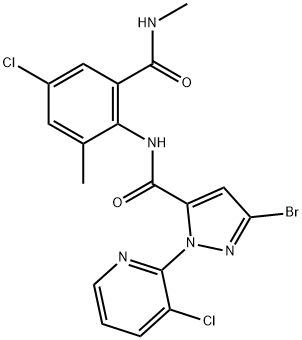Chlorantraniliprole

|
- ₹0
- Product name: Chlorantraniliprole
- CAS: 500008-45-7
- MF: C18H14BrCl2N5O2
- MW: 483.15
- EINECS:
- MDL Number:MFCD11840831
- Synonyms:CHLORANTRANILIPROLE;Rynaxpyr;DPX E2Y45;Chlorantraniliprole 95%;Chlorantraniliprole Standard;Coragen;Chlorantraniliprole 95% (Rynaxypyr, Coragen);Chlorantraniliprole Solution, 1000ppm
| Manufacturer | Product number | Product description | Packaging | Price | Updated | Buy |
|---|
Properties
Melting point :approximate 225℃ (dec.)
Boiling point :526.6±50.0 °C(Predicted)
Density :1.66±0.1 g/cm3(Predicted)
storage temp. :2-8°C
solubility :Chloroform: Slightly Soluble; DMSO: Slightly Soluble
form :A solid
pka :10.19±0.70(Predicted)
color :White to off-white
LogP :3.641 (est)
CAS DataBase Reference :500008-45-7
EPA Substance Registry System :1H-Pyrazole-5-carboxamide, 3-bromo-N-[4-chloro-2-methyl-6-[(methylamino)carbonyl]phenyl]-1-(3-chloro-2-pyridinyl)- (500008-45-7)
Boiling point :526.6±50.0 °C(Predicted)
Density :1.66±0.1 g/cm3(Predicted)
storage temp. :2-8°C
solubility :Chloroform: Slightly Soluble; DMSO: Slightly Soluble
form :A solid
pka :10.19±0.70(Predicted)
color :White to off-white
LogP :3.641 (est)
CAS DataBase Reference :500008-45-7
EPA Substance Registry System :1H-Pyrazole-5-carboxamide, 3-bromo-N-[4-chloro-2-methyl-6-[(methylamino)carbonyl]phenyl]-1-(3-chloro-2-pyridinyl)- (500008-45-7)
Safety Information
| Symbol(GHS): |

|
||||||||||||||
|---|---|---|---|---|---|---|---|---|---|---|---|---|---|---|---|
| Signal word: | Warning | ||||||||||||||
| Hazard statements: |
|
||||||||||||||
| Precautionary statements: |
|
Description
Chlorantraniliprole (Rynaxpyr) is an insecticide of the ryanoid class. It is a new compound by DuPont belonging to a new class of selective insecticides (anthranilic diamides) featuring a novel mode of action (group 28 in the IRAC classification). It is the first anthranilic diamide registered for use on turf- grass and landscape ornamentals. It is used to control a broad spectrum of pests including cabbage loopers, corn borers, Colorado potato beetle, European grapevine moth, armyworms and cutwormson a range of crops including potatoes and cotton. Its mechanism of action is through activating the insect ryanodine receptors (RyRs), further stimulating the release and depletion of intracellular calcium stores from the sarcoplasmic reticulum of muscle cells, causing impaired muscle regulation, paralysis and ultimately death of sensitive species.More related product prices
Cyhalothrin Sulfoxaflor Clothianidin Indoxacarb Pymetrozine Cyantraniliprole Thiamethoxam Admire Dinotefuran SPIROTETRAMAT Formamide BenzamideRelated product price
- Cyhalothrin
₹8064.63 - Clothianidin
₹16713.8 - Indoxacarb
₹12167.3
Suppliers and manufacturers
ATK CHEMICAL COMPANY LIMITED
Meryer (Shanghai) Chemical Technology Co., Ltd.
Anhui DIHE Yongxin Pharmaceutical Co., Ltd.
Hangzhou Taorui Biotechnology Co., Ltd
Beijing Qinchengyixin Technology Development Co., LTD
Suzhou Haiben Pharmaceutical Co., Ltd
Wuhan Rongcan Biotechnology Co., Ltd
Nanjing Sunlida Biological Technology Co., Ltd.
Wuhan xinyangruihe Chemical Technology Co., Ltd.






